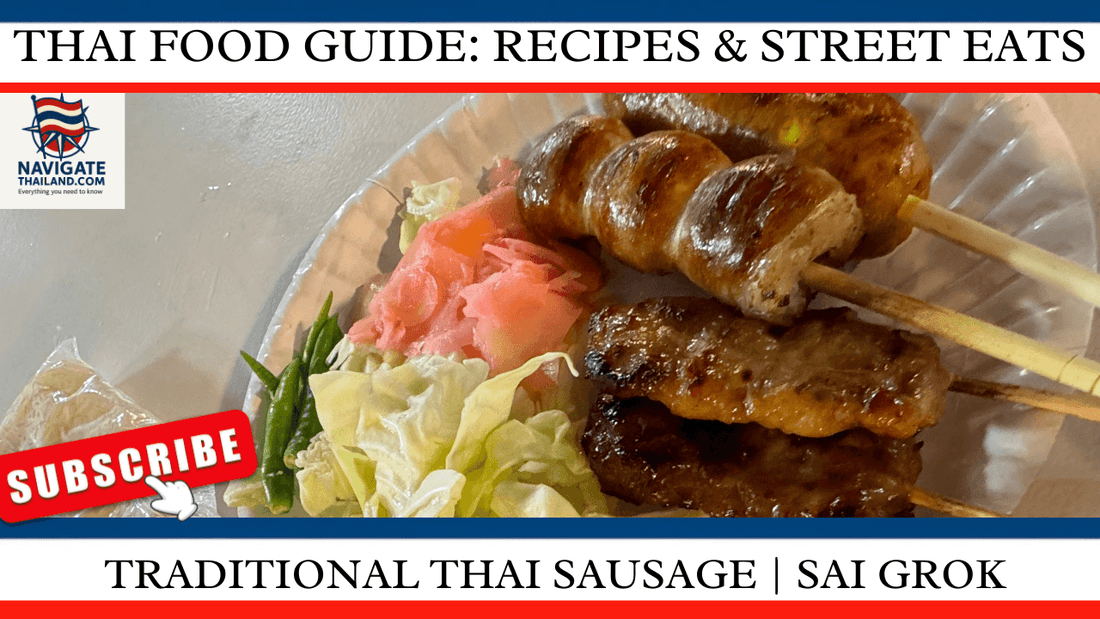
Traditional Thai Sausage: Sai Grok Isaan
Share
Thailand’s vibrant and diverse culinary landscape is filled with mouth-watering dishes that excite food lovers worldwide. One such delicacy, particularly from the northeastern region of Thailand, known as Isaan, is Sai Grok Isaan— the famous fermented Thai sausage. Known for its bold, tangy flavours, this sausage has become a must-try for travellers visiting Thailand and those looking to explore traditional Thai cuisine.
Sai Grok Isaan is a sausage like no other. Its unique preparation, where fermentation plays a key role, gives it a distinctive taste that sets it apart from other sausages around the world. Whether enjoyed as a snack, paired with sticky rice, or grilled on street-side stalls, Sai Grok has become an iconic symbol of Isaan's culinary identity. In this blog, we will explore everything you need to know about this delicious sausage, from its ingredients and preparation methods to nutritional information and tips for enjoying it during your travels in Thailand.
What is Sai Grok Isaan?
Sai Grok Isaan, also known as Thai fermented sausage, is a traditional sausage originating from the Isaan region of northeastern Thailand. This region is known for its rustic and flavourful cuisine, with influences from neighbouring Laos. The sausage is typically made from ground pork, sticky rice, garlic, salt, and sometimes pork fat, all of which are combined and allowed to ferment for a few days, giving the sausage its characteristic sour flavour.
Unlike most sausages that are cured or smoked, Sai Grok relies on natural fermentation to develop its taste. Once fermented, the sausage is often grilled over charcoal or fried, giving it a crispy, caramelised exterior while maintaining a juicy, tangy interior. The fermentation process also acts as a preservative, making it ideal for consumption in Thailand’s warm climate.
Ingredients in Sai Grok Isaan
The ingredients used in making Sai Grok Isaan are simple but come together to create a powerful burst of flavour. Here’s a look at what goes into this popular Isaan sausage:
Ground Pork: The base of the sausage, ground pork provides the meatiness and fat that gives Sai Grok its juicy texture. Some variations also use pork fat to add extra richness.
Sticky Rice: Cooked sticky rice is added to the sausage mixture, which plays an important role in the fermentation process. The starch in the rice feeds the bacteria, creating the sour flavour that defines the sausage.
Garlic: Fresh garlic is finely chopped and mixed into the sausage to provide a sharp, pungent taste that enhances the overall flavour profile.
Salt: Salt is a crucial ingredient not only for seasoning but also to control the fermentation process by regulating the growth of bacteria.
Pepper: Ground pepper is commonly added for a subtle heat that balances the tanginess.
Cabbage, Chilli, and Ginger (For Serving): Sai Grok Isaan is traditionally served with fresh vegetables like cabbage, green chillies, and thin slices of ginger, which provide a refreshing contrast to the rich and tangy sausage.
Fun Fact: The fermentation process in Sai Grok Isaan can take anywhere from 1 to 3 days, depending on the weather and how tangy you want the sausage to be. The warmer the weather, the quicker the fermentation!
How is Sai Grok Isaan Made?
The preparation of Sai Grok Isaan is relatively simple but requires some time and patience due to the fermentation process. Here’s how it’s traditionally made:
1. Preparing the Meat Mixture: Ground pork is mixed with cooked sticky rice, minced garlic, salt, and pepper. This combination is kneaded until well-blended.
2. Stuffing: The meat mixture is then stuffed into natural casings, typically pork intestines, which are tied off at regular intervals to form links.
3. Fermentation: Once the sausages are formed, they are left to ferment at room temperature. The duration of fermentation depends on the desired sourness and the ambient temperature. The fermentation process not only develops the characteristic tangy flavour but also acts as a natural preservative.
4. Cooking: After fermentation, Sai Grok Isaan is typically grilled over a charcoal fire or pan-fried until the skin is crispy and slightly charred. The cooking process adds a smoky depth to the already complex flavour of the sausage.
The best way to enjoy Sai Grok Isaan is freshly grilled, accompanied by sticky rice and fresh herbs or vegetables like ginger, cabbage, and green chillies. The sourness of the sausage, combined with the heat of the chillies and the crunch of fresh vegetables, creates a truly authentic and satisfying Isaan dining experience.
Nutritional Value of Sai Grok Isaan
While Sai Grok Isaan is a delicious treat, it’s also important to understand its nutritional content, especially for those who are conscious about their diet. Here’s a general overview of the nutritional value of a standard serving of grilled Sai Grok Isaan (approximately 100g):
Calories: 300-350 kcal
Protein: 16-20g
Fat: 25-30g
Carbohydrates: 2-5g
Sodium: 800-1000mg
Sai Grok Isaan is a rich source of protein, thanks to the pork used in its preparation. However, it is also relatively high in fat and sodium, making it a dish best enjoyed in moderation. The fermentation process can aid digestion, as the natural bacteria help break down the meat and rice.
Fun Fact: Despite being a fermented food, Sai Grok Isaan doesn’t have an overly pungent smell like some other fermented dishes. The flavour, while tangy, is balanced by the rich and savoury taste of the pork.
The History and Evolution of Sai Grok Isaan
Sai Grok Isaan has its roots in the rural communities of the Isaan region, where food preservation methods like fermentation were commonly used to extend the shelf life of meats in the absence of refrigeration. The practice of fermenting pork with sticky rice became a staple in the region, not only for its practical benefits but also because of the unique flavour it produced.
The dish has evolved over time and spread throughout Thailand, becoming a popular street food in cities like Bangkok and Chiang Mai. Despite its widespread popularity, Sai Grok Isaan has retained its connection to the rural traditions of Isaan, where it continues to be made using traditional methods.
Today, you can find Sai Grok Isaan sold at street stalls, markets, and even restaurants across Thailand. The preparation methods remain largely unchanged, though some variations may include different spices or cooking techniques depending on the region or individual preferences.
Fun Fact: Sai Grok Isaan is often served as a snack or appetiser in Thailand but can also be part of a larger meal when paired with dishes like **som tam** (green papaya salad) and **laab** (spicy minced meat salad).
Where to Try Sai Grok Isaan
If you’re visiting Thailand, you’ll find that Sai Grok Isaan is widely available, especially in the northeast and in street food markets across the country. Some of the best places to try this delicious sausage include:
Bangkok’s Street Markets: Head to **Chatuchak Market** or **Rod Fai Night Market** to find vendors grilling fresh Sai Grok Isaan. These markets offer a vibrant atmosphere where you can sample a variety of traditional Thai dishes.
Isaan Region: If you’re looking for an authentic experience, there’s no better place to try Sai Grok Isaan than in its birthplace. Cities like **Khon Kaen**, **Udon Thani**, and **Nakhon Ratchasima** have plenty of local eateries that serve the sausage, often paired with sticky rice and other regional favourites.
Chiang Mai Night Bazaar: In northern Thailand, Chiang Mai’s famous night bazaar is a hotspot for street food, including Sai Grok Isaan. Here, you’ll find the sausage grilled to perfection and served with a variety of fresh herbs and vegetables.
Fun Fact: In Isaan, locals often pair Sai Grok Isaan with a shot of **Lao Khao**, a traditional Thai rice whiskey, as part of a lively meal enjoyed with friends and family.
Conclusion
Sai Grok Isaan is more than just a sausage—it’s a reflection of the rich culinary traditions of the Isaan region and a symbol of the ingenuity of rural Thai cuisine. Its unique fermentation process, combined with simple yet flavourful ingredients, makes it a dish that is beloved by locals and an exciting culinary adventure for travellers.
Whether you’re strolling through a busy market in Bangkok or exploring the countryside of Isaan, be sure to try this iconic sausage and experience the bold flavours of northeastern Thailand. Pair it with sticky rice, fresh vegetables, and a cold drink for the perfect street food experience.
Have you tried Sai Grok Isaan during your travels? Share your experiences in the comments below! And don’t forget to share this blog with your friends on social media. Stay tuned for more exciting content, and remember that we turn our blogs into videos, so like and subscribe to our YouTube channel to stay updated on all things related to Thai cuisine and culture.
References:
National Geographic
Isaan Record – https://www.isaanrecord.com
Read more of our Thailand blog series:
Thai Food Guide:Traditional Recipes and Street Eats
Everything Travellers Need to know
Thailand travel ebooks and language guides
Thailand Travel Apparel & Souvenir Gifts
Subscribe to our YouTube channel Navigate Thailand to see our most popular Thailand travel blogs turned into videos:
Navigate Thailand YouTube channel










































































































































